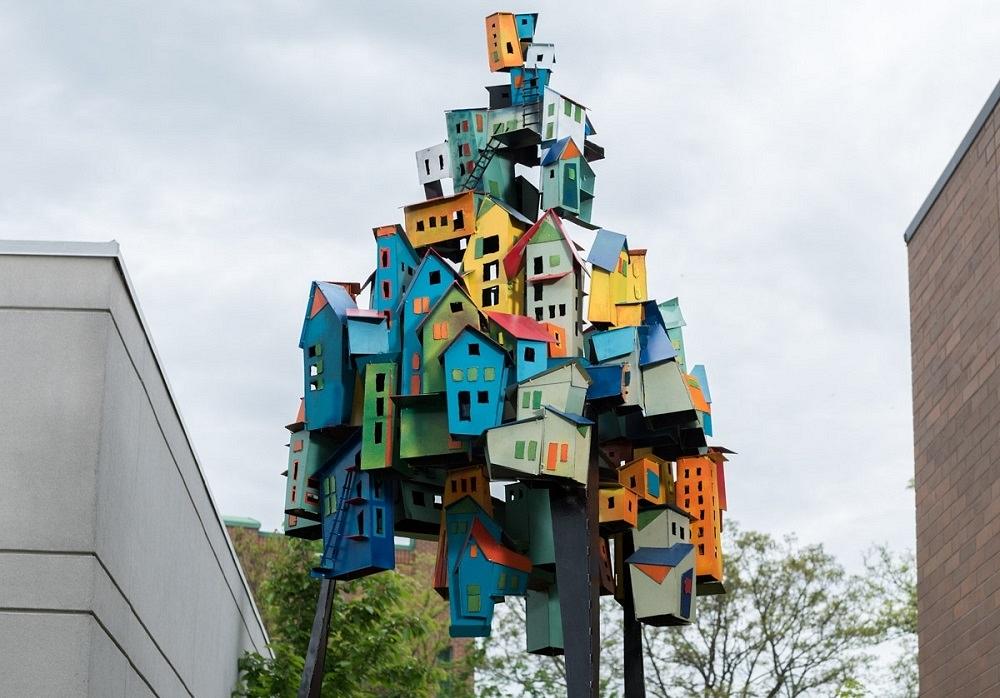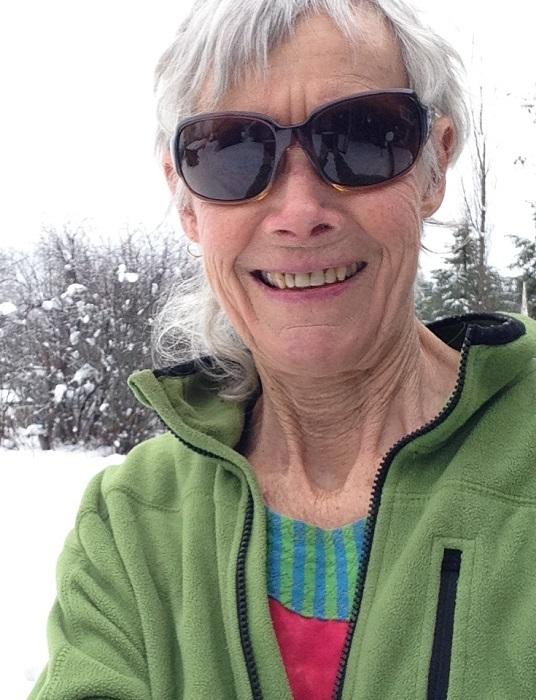- FMA
- The Fabricator
- FABTECH
- Canadian Metalworking
Categories
- Additive Manufacturing
- Aluminum Welding
- Arc Welding
- Assembly and Joining
- Automation and Robotics
- Bending and Forming
- Consumables
- Cutting and Weld Prep
- Electric Vehicles
- En Español
- Finishing
- Hydroforming
- Laser Cutting
- Laser Welding
- Machining
- Manufacturing Software
- Materials Handling
- Metals/Materials
- Oxyfuel Cutting
- Plasma Cutting
- Power Tools
- Punching and Other Holemaking
- Roll Forming
- Safety
- Sawing
- Shearing
- Shop Management
- Testing and Measuring
- Tube and Pipe Fabrication
- Tube and Pipe Production
- Waterjet Cutting
Industry Directory
Webcasts
Podcasts
FAB 40
Advertise
Subscribe
Account Login
Search
Scrap metal expands Canadian artist’s forte into welding
British Columbian Rabi’a considers herself “an artist who welds”
- By Sue Roberts
- December 1, 2019
- Article
- Metals/Materials

Eight-foot tall “Housing Crisis” was the first welded sculpture Rabi’a made using purchased, rather than found, steel. Photo provided by Rabi'a
Flower gardens, berry patches, straw-bale B&B cottages, and sculptures—lots of sculptures—grace an artist’s 5 acres just outside the community of Winlaw, B.C., Canada.
All peacefully coexist under the watchful eye of Rabi’a, who embraced her artistic leanings as she approached her 60th birthday. That was in 2003. Since then her robust curiosity, appreciation for the environment, and dedication to sustainable practices are reflected in her art and her material choices.
In many cases, the inspiration and components for her mosaics, fabric banners, magnetic vinyl designs, and sculptures come from found or discarded items. About 10 years ago she discovered working with scrap metal.
“I was well into my 60s when I decided that welding was the next thing to do. I started collecting all kinds of scrap and bits of leftover metal. Some interesting pieces come from scrap-yards or abandoned mining sites. Local weld shops let me scrounge through the scrap bins. Sometimes I find stunning pieces. I love the negative spaces,” Rabi’a said.
“When I first started working with metal, I would take my pieces to a weld shop to be tacked together. That worked to create the sculptures, but it was hard to make any changes during the welding process.
“My partner, Carl Schlichting, who is also an artist and welder, suggested I start welding. That led to adding a Millermatic MIG welder to my studio. I had help learning how to turn it on and work with the gas pressures. The rest was self-taught.
“I learned that if something is too rusty, you grind it clean where you want the weld. Most of my pieces start off rusty because they’ve been outside for years, and stay that way.”
Canada’s Sculpture Capital
Castlegar, 30 miles south of Winlaw, is the self-proclaimed Sculpture Capital of Canada. The city sponsors a Sculpturewalk from May to October each year. Viewers vote for their favorite piece of public art and the winner of the People’s Choice Award becomes a permanent part of the city’s collection. Other entries are available for sale or often are leased for display in other communities.
Rabi’a’s first entry in the Sculpturewalk in 2008 was her first welded sculpture named “Huge and Foolish.” She said it was large and had intricate angles that made it “foolishly” ambitious for a beginning welder, but it enhanced her welding skills.
Those skills continued to improve, and in 2016 another large sculpture, a joint project with Schlichting, won the People’s Choice Award. The 4- by 4- by 12-ft. sculpture, “Imagine the Stories,” resides in front of Castlegar’s district library.
One of her two sculptures in the 2019 event depicts a mother and child. The life-sized sculpture, named “Let’s Go,” combines welding and mosaic art. Steel is used for the structure and the woman’s purse. Mosaic pieces glued to the steel using silicon provide color and an interesting pattern, and grout between the glass pieces smooths the outer surface. The hat is bronze because, Rabi’a said, “I couldn’t crumple the steel.”
The sculpture was purchased by the city of Revelstoke, about 10 miles north of Castlegar, for display at the public library entrance.
In its original form, “Let’s Go” had a third figure but the overall size was too bulky for the Castlegar display. “I’m not above altering my work, so I took one of the figures off and it lives in my yard.
“I really like figurative sculptures,” she said. “Once I learned to weld, I couldn’t believe how many of the oddest pieces could be joined together to become figures. Looking at a piece of rusty metal, you would never believe that it could be an arm, leg, or torso, but when I weld it all comes together.”
Much More to Do
Rabi’a doesn’t like the pressure that comes with commissioned work. “I make what I want to make with materials I have. The only things I make for a purpose are for the Sculpturewalk. Even then, I can still do what I want.”
Welding, she said, has had a great impact on the art she wants to do. So much so that she purchased new material for the first time. Clean, new 4- by 8-ft. sheets of steel were used to create the “Housing Crisis” sculpture.
“My journey as an artist started late, so I feel like I have a lot of catching up to do. So far, of all my processes, I’m most enamored with welding, but I don’t call myself a welder. I call myself an artist who welds.”
About the Author

subscribe now

The Fabricator is North America's leading magazine for the metal forming and fabricating industry. The magazine delivers the news, technical articles, and case histories that enable fabricators to do their jobs more efficiently. The Fabricator has served the industry since 1970.
start your free subscription- Stay connected from anywhere

Easily access valuable industry resources now with full access to the digital edition of The Fabricator.

Easily access valuable industry resources now with full access to the digital edition of The Welder.

Easily access valuable industry resources now with full access to the digital edition of The Tube and Pipe Journal.
- Podcasting
- Podcast:
- The Fabricator Podcast
- Published:
- 04/16/2024
- Running Time:
- 63:29
In this episode of The Fabricator Podcast, Caleb Chamberlain, co-founder and CEO of OSH Cut, discusses his company’s...
- Industry Events
16th Annual Safety Conference
- April 30 - May 1, 2024
- Elgin,
Pipe and Tube Conference
- May 21 - 22, 2024
- Omaha, NE
World-Class Roll Forming Workshop
- June 5 - 6, 2024
- Louisville, KY
Advanced Laser Application Workshop
- June 25 - 27, 2024
- Novi, MI

































